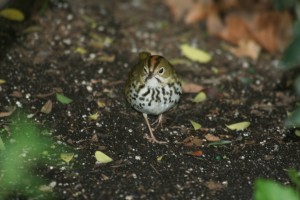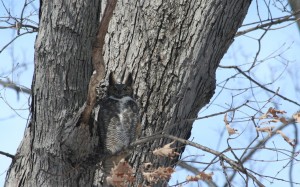Fall Bird Watching Finds Migrants and Winter Species
Posted in Wildlife on November 5 2010, by Plant Talk
Owls, Hawks, Sparrows, Even Wild Turkeys, Seen on Free Weekly Walks
 |
Debbie Becker leads a free bird walk at the Garden every Saturday from 11 a.m. to 12:30 p.m., beginning at the Reflecting Pool in the Leon Levy Visitor Center. Photos by Debbie Becker. |
 Fall arrives with a hint of winter and a longing for summer. The leaves fall and the trees begin to go dormant. For me and other birders, fall signifies transition with the migration of birds. The herons, egrets, and catbirds all leave for warmer climates. Their time in New York City has come to an end, and they flee before winter arrives. But with the fall, too, comes the arrival to New York of the winter birds: juncos, white-throated sparrows, chickadees, titmice, ducks, and owls. Some birders think that winter birding is the best, and it begins in the fall.
Fall arrives with a hint of winter and a longing for summer. The leaves fall and the trees begin to go dormant. For me and other birders, fall signifies transition with the migration of birds. The herons, egrets, and catbirds all leave for warmer climates. Their time in New York City has come to an end, and they flee before winter arrives. But with the fall, too, comes the arrival to New York of the winter birds: juncos, white-throated sparrows, chickadees, titmice, ducks, and owls. Some birders think that winter birding is the best, and it begins in the fall.
 Autumn is sparrow season, and this fall has proven to be a spectacular one at that. So far at NYBG we have spotted field, tree, clay-colored, song, white-crowned, swamp, savannah, chipping, and white-throated (pictured above) sparrows. Along with the flocks of sparrows are yellow-rumped warblers and an assortment of other migrating birds: common yellowthroats, blackpolls, American redstarts, ovenbirds (one pictured at left), black-and-white warblers, black-throated green warblers, black-throated blue warblers, grosbeaks, tanagers, and a variety of vireos and flycatchers.
Autumn is sparrow season, and this fall has proven to be a spectacular one at that. So far at NYBG we have spotted field, tree, clay-colored, song, white-crowned, swamp, savannah, chipping, and white-throated (pictured above) sparrows. Along with the flocks of sparrows are yellow-rumped warblers and an assortment of other migrating birds: common yellowthroats, blackpolls, American redstarts, ovenbirds (one pictured at left), black-and-white warblers, black-throated green warblers, black-throated blue warblers, grosbeaks, tanagers, and a variety of vireos and flycatchers.
We have also spotted overhead at Daffodil Hill migrating turkey vultures, osprey, Cooper’s hawks, sharp-shinned hawks, a kestrel, a rough-winged hawk, and a wonderful merlin that soared in the sunlight, illuminating the copper and red in its wings.
 The great horned owls that now inhabit the Forest at NYBG are second generation, as the longtime resident male and female have since died. A junior male (pictured), a possible offspring of the pair, and a new mate have staked their territory. It is amazing to see the junior male roosting in the same spot where the former owls did. He carries on the tradition of hooting in the same Forest area; we look forward to seeing their owlets.
The great horned owls that now inhabit the Forest at NYBG are second generation, as the longtime resident male and female have since died. A junior male (pictured), a possible offspring of the pair, and a new mate have staked their territory. It is amazing to see the junior male roosting in the same spot where the former owls did. He carries on the tradition of hooting in the same Forest area; we look forward to seeing their owlets.
Yellow-bellied sapsuckers, a name that always elicits a laugh, are plentiful at the Garden as are other woodpeckers: hairy, downy, and a persistent red-bellied that can be observed by Twin Lakes. It flies back and forth, grabbing acorns from an oak and depositing them in an open knot in a tree, storing them for winter.
Chickadees and titmice have arrived in record numbers. Recently we watched a brown thrasher by the crabapples wandering up the road as a hermit thrush and eastern phoebe looked on. Cedar waxwings and robins that will spend the winter at the Garden were eating berries from a polycarpa tree. Grackles, which migrate in the thousands, have begun lighting on nearby lawns.
Before you start thinking about Thanksgiving, come see the two wild turkeys that are regularly seen behind Shop in the Garden. They peck and scrape the gravel and grass looking for morsels to feed on.
I look forward to cool days with misty air—and birds that delight us. Come join us on a walk.

